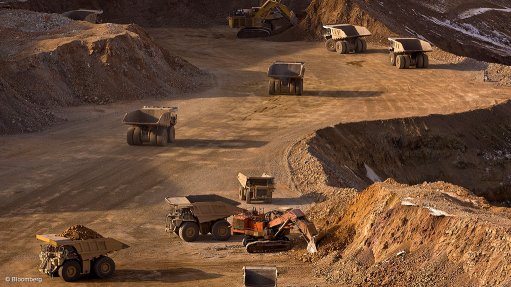
Photo by: Bloomberg
PERTH (miningweekly.com) – The latest data from the Bureau of Resources and Economics (BREE) has revealed that the downward spiral in commodity prices has resulted in an increase in the number of resource projects either being delayed or deferred.
BREE stated in its latest 'Resources and Energy Major Projects' report that these conditions would likely persist over the medium term, as the markets adjusted to soak up additional supplies and until economic conditions in key trading areas supported further growth.
“Declining commodity prices have continued to weigh on investment decisions with many developers revisiting project feasibility studies amid weaker than expected prices,” said BREE deputy executive director Wayne Calder.
“The renewed industry-wide focus on improving productivity and lowering costs has extended to new projects. Developers are reassessing their plans and considering less capital intensive options to improve the economics of their projects.”
Calder said that this has been observed through revisions to the schedules and parameters of a number of projects, which has slowed the entry and progression of projects through the BREE development pipeline.
Over the past six months, five resources and energy projects worth a combined $1.2-billion were completed in Australia.
In the six months to October 2014, three projects worth $597-million were identified as receiving a positive final investment decision and progressed to the committed stage; however, BREE noted that this was the lowest number and value of projects moving to the committed stage in more than a decade.
In October, there were 44 projects at the committed stage with a combined value of $228-billion compared with 48 projects with a combined value of $229-billion six months earlier.
BREE noted that liquefied natural gas (LNG) projects continued to drive resource and energy investment in Australia, accounting for around 87% of the value of committed projects.
The slower rate of project progression is also evident at earlier stages of development in the BREE investment pipeline. The number of projects at the publicly announced stage is now 19 less than in April 2014 and the number at the feasibility stage is eight lower than in the same period.
Furthermore, companies were also cutting back on exploration spend, with BREE reporting that total exploration expenditure, including both minerals and petroleum exploration, decreased 12% to $6.9-billion in 2013/14.
Investment in the Australian resources and energy sector was projected to moderate in the medium term as the large LNG projects were completed.
BREE noted that projects currently progressing through the development pipeline were unlikely to be of a scale sufficient to offset the reduction in investment associated with the completion of the ‘mega’ LNG projects.
The research body added that despite the subdued outlook for resource and energy investment in Australia there were still opportunities for future investment in the sector.
“The realisation of these opportunities will be determined by global market conditions and Australia’s ability to regain cost competitiveness.”